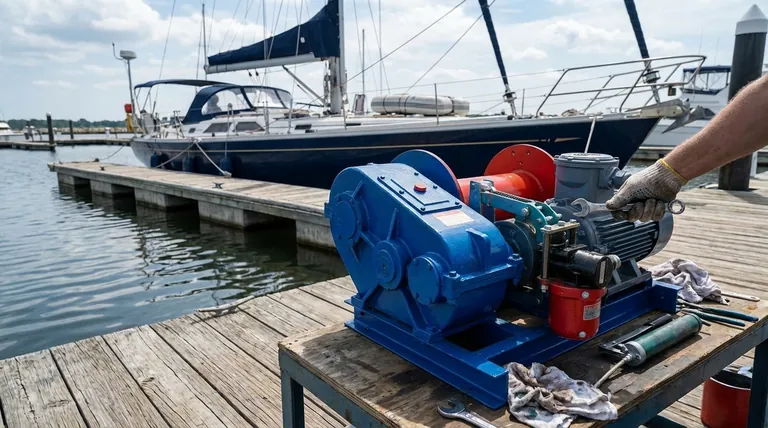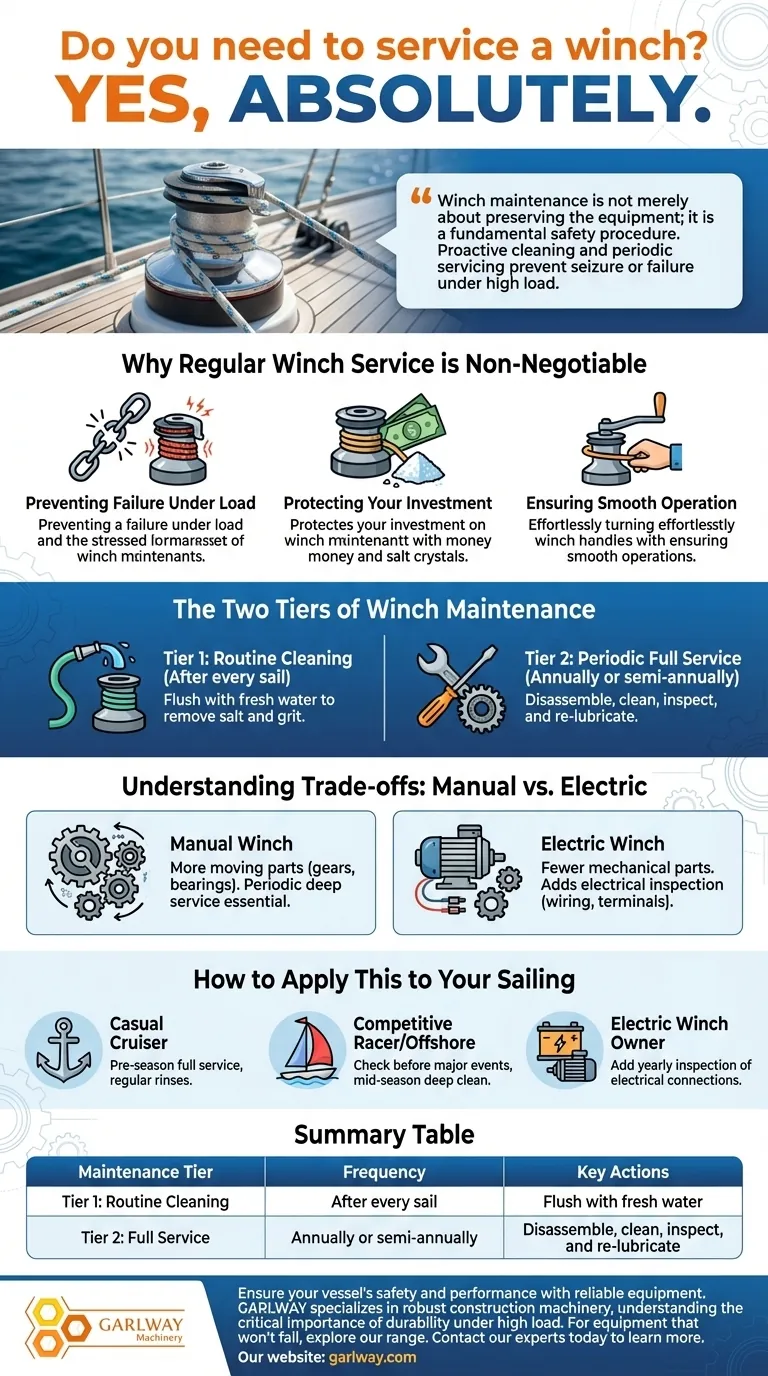Yes, absolutely. Servicing your winch is a critical maintenance task for any sailboat owner. As a general rule, you should perform a full service before the sailing season begins and at least once more during the season, with more frequent checks for boats that are raced hard.
Winch maintenance is not merely about preserving the equipment; it is a fundamental safety procedure. Proactive cleaning and periodic servicing prevent seizure or failure under high load, ensuring your gear is reliable when you need it most.

Why Regular Winch Service is Non-Negotiable
A winch is a powerful force multiplier, and the loads placed upon it are immense. Neglecting its maintenance introduces significant and unnecessary risk.
Preventing Failure Under Load
The most critical reason for winch service is to prevent catastrophic failure. A winch that seizes, slips, or breaks under the load of a sail can lead to dangerous situations for the crew and damage to the vessel.
Protecting Your Investment
Winches are complex, expensive pieces of hardware. Salt, grit, and old, hardened grease act as an abrasive compound, accelerating wear on internal gears, bearings, and pawls. Regular cleaning and lubrication dramatically extend their operational life.
Ensuring Smooth Operation
A well-maintained winch operates smoothly and efficiently. This makes sail handling easier, faster, and less physically demanding for the crew, directly impacting performance and enjoyment on the water.
The Two Tiers of Winch Maintenance
Effective winch care can be broken down into two simple categories: routine cleaning and periodic deep servicing.
Tier 1: Routine Cleaning
The simplest and most frequent task is to flush your winches with fresh water after sailing. This removes corrosive salt crystals and grit that can work their way into the mechanism, preventing premature wear.
Tier 2: Periodic Full Service
This is a more involved process performed annually or semi-annually. It involves disassembling the winch drum, cleaning all internal components of old grease, and inspecting the pawls and springs for wear before re-greasing and reassembly.
Understanding the Trade-offs: Manual vs. Electric
While all winches require care, the specific tasks can vary by type.
Manual Winch Maintenance
A standard manual winch has numerous moving parts—gears, bearings, pawls, and springs—that must be periodically disassembled, cleaned, and lubricated. This full service is essential for its mechanical health.
Electric Winch Maintenance
As noted in technical documentation, electric winches often have fewer moving mechanical parts. This can reduce the frequency or complexity of mechanical servicing. However, this simplicity is traded for the addition of an electrical system that also requires inspection, including wiring, terminals, and motor seals.
How to Apply This to Your Sailing
Your maintenance schedule should reflect how you use your boat. A proactive approach is always the safest and most cost-effective strategy.
- If you are a casual or coastal cruiser: A full service before the season and regular freshwater rinses are a solid foundation for reliability.
- If you are a competitive racer or offshore sailor: Check winch operation before every major event or passage. A mid-season deep clean and inspection is highly recommended.
- If you have electric winches: While the mechanical service may be simpler, add a yearly inspection of all electrical connections for corrosion and tightness.
Proper winch care is a direct investment in the safety, performance, and reliability of your vessel.
Summary Table:
| Maintenance Tier | Frequency | Key Actions |
|---|---|---|
| Tier 1: Routine Cleaning | After every sail | Flush with fresh water to remove salt and grit. |
| Tier 2: Full Service | Annually or semi-annually | Disassemble, clean, inspect parts, and re-lubricate. |
Ensure your vessel's safety and performance with reliable equipment from GARLWAY.
As a specialist in construction machinery, including robust winches, we understand the critical importance of durability and reliability under high load. While our expertise is grounded in construction, the principles of quality engineering and maintenance are universal.
For construction companies and contractors globally who demand equipment that won't fail, explore GARLWAY's range of durable machinery. Let's discuss how our engineering solutions can meet your heavy-duty needs.
Contact our experts today to learn more
Visual Guide

Related Products
- Electric and Hydraulic Winch for Heavy Duty Applications
- Warn Winch Windlass Boat Trailer Winch
- Electric 120V Boat Winch by Badlands
- Best 18000 Pound Drum Anchor Trailer Winch
- 12000 lb Heavy Duty Electric Boat Winch
People Also Ask
- How to maintain an electric winch? Ensure Peak Performance & Reliability for Your Projects
- What is the difference between electric winch and electric hoist? Essential Safety & Application Guide
- How long can you run an electric winch? Master Safe, Efficient Vehicle Recovery
- How is an electric winch powered? Unlock the Power Conversion System for Heavy Lifting
- Can an electric winch be used as a hoist? Understand the Critical Safety Differences



















